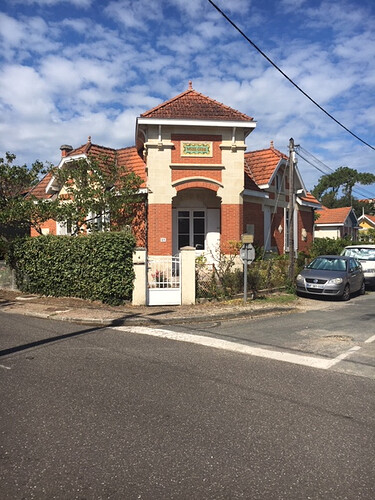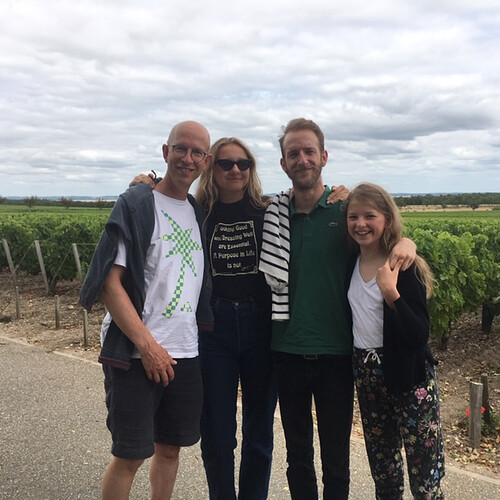For the last five years, we have been spending our summer holiday in Soulac, at the tip of the Médoc. It’s totally uncool, although not without a certain shabby chic. Soulac was fashionable in 1900 and is full of villas like this one:
The main attraction is the beach:
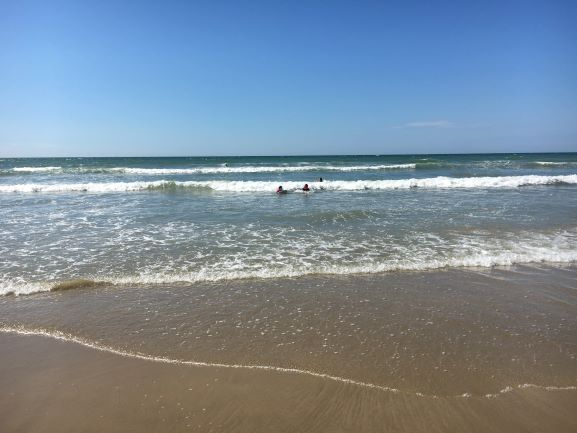
- the whole of the Atlantic coast from Soulac to a little north of Biarritz is one long, sandy beach, but plagued by dangerous baïnes (tidepools?), stretches of water between the shore and a sandbank, where you can be dragged out to sea by the undertow - except for where we go near Soulac, which is seldom affected, making it perfect for learning to surf.
This year as usual, our only plans were to do bodyboarding, surfing and cycling, but my son’s visit and a couple of cloudier days between heatwaves gave us the idea of visiting a château. The girls are now 15 and 13 and starting to be curious about Daddy’s obsession. After one great success, we visited another, and another, and even another. None of these were planned, they were all last minute decisions and I didn’t take many photos. For the first, we chose somewhere close, just 45 minutes away:
Sociando-Mallet
As with the subsequent visits, we had a private tour - literally, since we were the only people there apart from our guide, Margaux, who was very knowledgeable and kind, explaining very well the more technical details to our daughters. We had visited in 2001 and the changes made since are jaw-dropping. The facilities were already impressive then, but even more so now, with all the state-of-the-art equipment we were to see in the CCs elsewhere.
I’m not going to detail how the wines are made, since Neal’s article a few months back does all that much better than I could, but one point I hadn’t understood before was the size of the annual production: 300 to 350 000 bottles of SM, plus 120 to 150 000 bottles of la Demoiselle and a further 4 500 bottles of la Cuvée Jean Gautreau. I was particularly curious about the latter, since Neal’s article stated that only 900 bottles were produced. There are indeed about 80 barrels initially, which we saw in their own cellar, but 15 or so of these are selected for the final Cuvée.
Since our last trip, what struck us was the size of the new buildings - partly for the higher production but also for storage of older vintages, of which there are hundreds of thousands of bottles stacked up. It’s hardly surprising that SM is not a speculator’s wine. Also, like elsewhere, much more care is being taken to receive guests and visitors properly. The new tasting room with the superb views over the vineyard which you can see in Neal’s report is particularly impressive. Also, there is a walking tour visitors can do through the vineyard and a gîte to stay in overlooking the river (very pretty - 350€ for the weekend for four - Château Sociando-Mallet - The Gite).
In spite of the heatwaves this year, the vines themselves looked fine, as you can see here (I’m the baldy, with Emma, Leicester and Daphne):
As elsewhere, SM are planning on increasing the proportion of CS and reducing the amount of Merlot.
We tasted a rosé (forgotten the name!), la Demoiselle 2013, SM 2012 and la Cuvée JG 01. The 2013 was as you would expect, the 2012 was developing well, but the star was the JG 01. Compared to the normal wine from 2001, which is already excellent, the JG is just a little bit bigger and better IMHO.
The best surprise was right at the end, when we were asked (not at all pushily) if we would like to visit the shop. Since, unlike everywhere else, the visit was, like in the olden days, free, I felt like buying the odd bottle as a souvenir, so off we went, where I discovered to my amazement the entire collection of La Cuvée Jean Gautreau from 1995 to 2014, along with numerous vintages of SM, also in halves and magnums. It was wonderful and awful, since the JG is practically impossible to find, but I knew that unless I threw out most of our clothes, I only had room in the car for 6 bottles…but happily, since then I have found out that they will ship to our home so I can get some more!
Anyway, a great visit which I thoroughly recommend. Our daughters were hooked - fascinated by the whole experience, so I’m glad I bought them their birth-year cases!
Haut Bages Libéral
Another rainy day so we headed to Pauillac. No photos, but you can see what it all looks like here: http://www.hautbagesliberal.com/
Again, massive changes have been made since our last visit, the most important of which is their decision to go organic, then bio-dynamic, which was carefully and cleverly explained by our guide, Geoffrey. They have completely phased out chemicals and copper treatment, in spite of which their production was unaffected by the mildew attacks which so reduced output elsewhere in 2018. Also, they are considerably reducing the amount of oak: already low at 40%, they intend to cut this down further, using small concrete vats instead of oak barrels. Their aim is to increase the focus on the fruit and to make the wines more accessible young, since they are conscious that less and less people have wine cellars today.
Compared to our last visit, what stood out was the spotlessness of the cellars, the improved state of the vines and the general attention to detail. I would expect great things to come from HBL in coming years.
We tasted a rosé (nothing special), the second wine from 2015, HBL 2012 and Acaibo 2012, their Californian wine, the most impressive of which was the 2015.
Gruaud Larose
Another estate we were re-discovering, the big change here is the observation tower. How on earth they were allowed to build it I cannot imagine, but it does give great views:
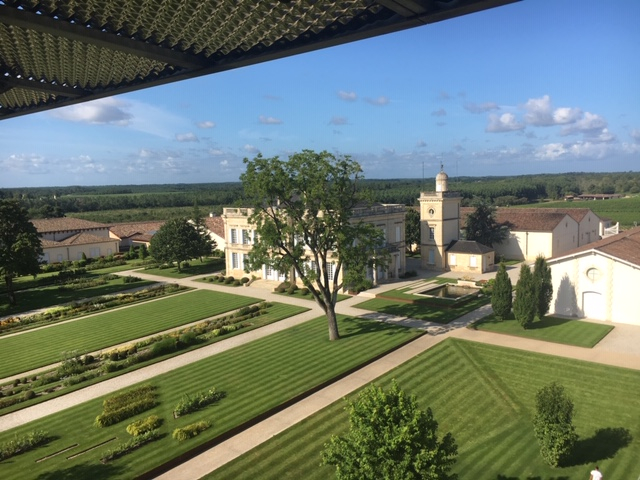
This one is interesting because you can see the difference between the Cabernet Sauvignon, planted at the front of the plot and the Merlot at the back.
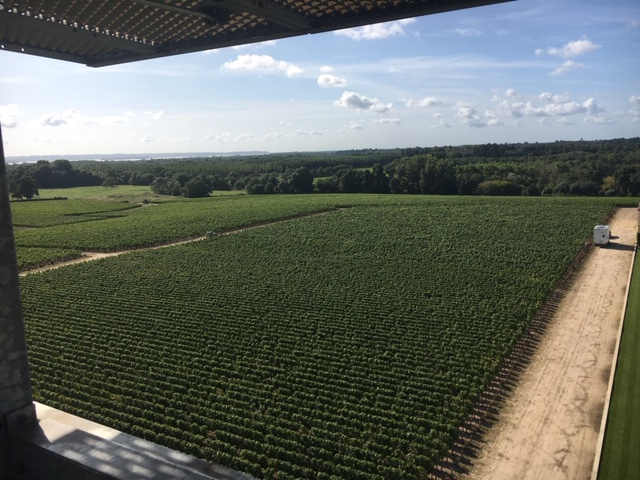
In the cellar, they were busy topping up the barrels of 2018, which was very interesting to see - and smell! When we walked into the cellar, we were hit by that wonderful aroma of slightly funky, briary and blackberry fruit which is so typical of Gruaud. The vinothèque is also really amazing - there is something very moving about seeing bottles of 1815 in racks within reach of one’s fingers. Otherwise, the winemaking equipment looks very similar to 15 years go - they still use the giant oak vats rather than the steel and cement vats seen everywhere else and apart from the new visitor’s centre, the tower and the anti-hail gun, Gruaud’s only noticeable shift is towards organic farming, for which they will get their certificate in a couple more years.
We tasted the Sarget 2016, the GL 2012 and the 2000, obviously the most impressive, with clearly a long future ahead.
Lafon-Rochet
The only estate we had not visited before, so perhaps the most interesting as a result. I’ve always had the impression of a wine that is up-and-coming, but still in the shadow of others at St. Estephe, and slightly lagging behind its former stablemate Pontet-Canet. Great progress has been made since the rather stodgy wines of the 80s, but not as much as others and it’s always been a bit frustrating. Now, however, all that looks to be changing. The new winemaking facilities are extremely impressive, not least aesthetically - this photo of the cement vats does not do them justice:
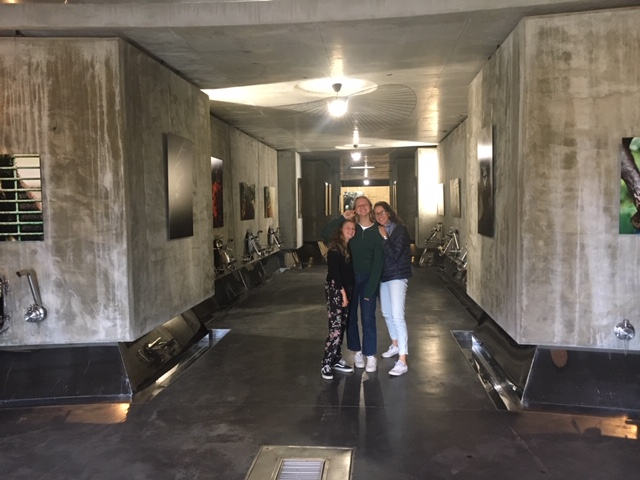
Again, there is the feeling of great attention to detail.
The château itself, along with the other buildings and the labels, is as you all probably know a rather “striking” shade of yellow, but having seen a photo of the château when Michel Tesseron tried the yellow along with other potential colours, a vibrant red and a rather mouldy green, we felt he chose the right one!
We tasted the 2018 from a barrel, which was fun, then the 2016 Les Pélérins, LR 2011 and LR 2014, in that order, which was tough on the last three, since the 2018 was really so much better. I hadn’t planned on buying any 2018s from any major château but I will certainly buy this one. It’s by far the best Lafon I’ve tried - what is impressive is the clarity of the fruit, the elegance and the finesse, not a word I thought I would use about LR. The balance is also excellent and we were surprised to learn that the wine is a whopping 14°5, since there was no sign of this in the taste.
Obviously the 2018 was an EP sample but should the final result prove as good, this will be an outstanding wine.
It was a great way to conclude our visits.
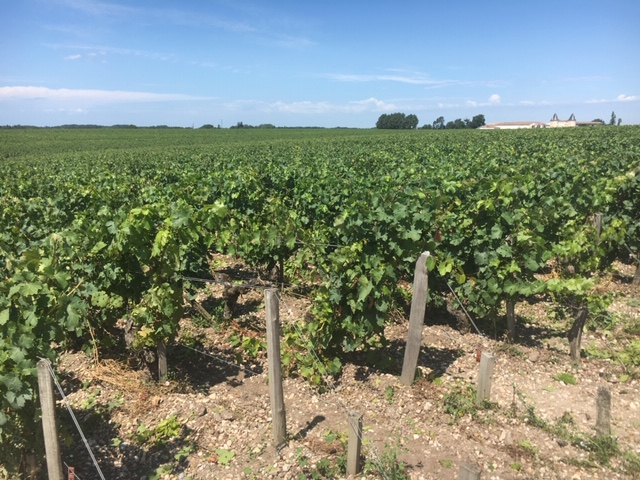
This is part of Lafon’s vineyard, with Lilian Ladouys in the background. As you can see, apart from one or two leaves, no sign of undue stress from the heatwaves. It rained a couple of times during the three weeks we were there and with more rain on the way this week and next week, they are getting the rain all were hoping for.
To conclude, it was all great fun and very interesting. Much has changed in Bordeaux since our last visits, with more attention given to visitors. Our guides were all far better than in the past. I imagine that some châteaux still lump people together into large groups, but we had no trouble at all in getting private visits.
Just a couple of gripes, however:
Some châteaux are still surprisingly reticent - Pontet-Canet was closed to visitors in peak season! Also, bearing in mind the huge sums invested in tourism facilities, it was somewhat surprising that only a small number are open on Saturdays and virtually none on Sundays. When are the people living and working in Bordeaux supposed to visit?! In the winter I could understand, but in peak tourism season, this is extraordinary.
The other big change is the move towards organic farming, which is clearly gathering pace, not before time.
One final point - if you like Bordeaux, have never done this and are worried about the language barrier, don’t be. Unlike before, visits can easily be conducted in English. It really is very easy to book appointments so no need to spend money on expensive wine tours and if you do it yourself, you get the chance to have a picnic lunch all on your own at the port at Beychevelle:
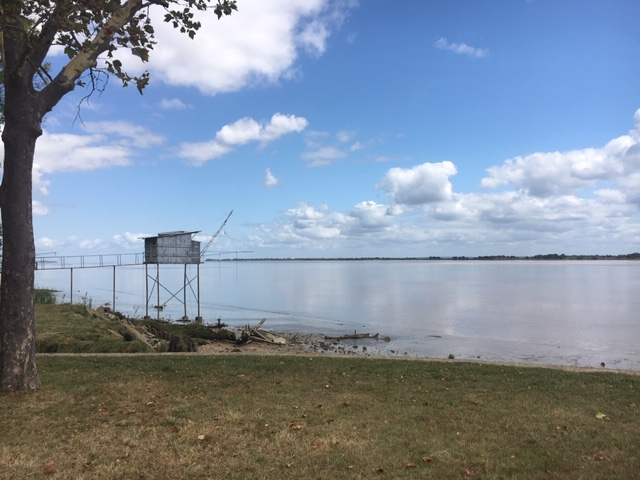
Cheers!
